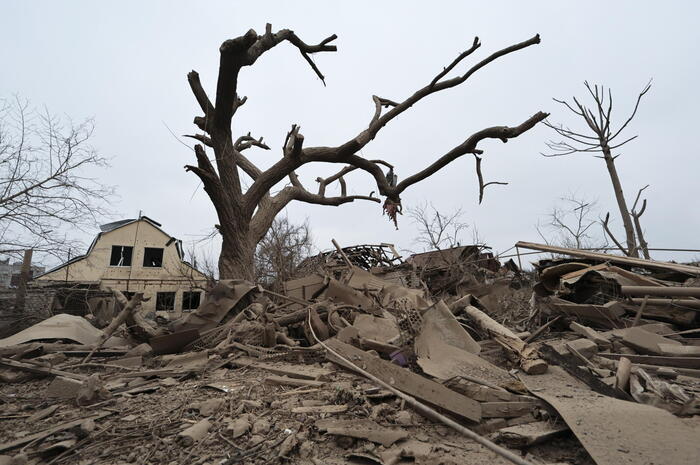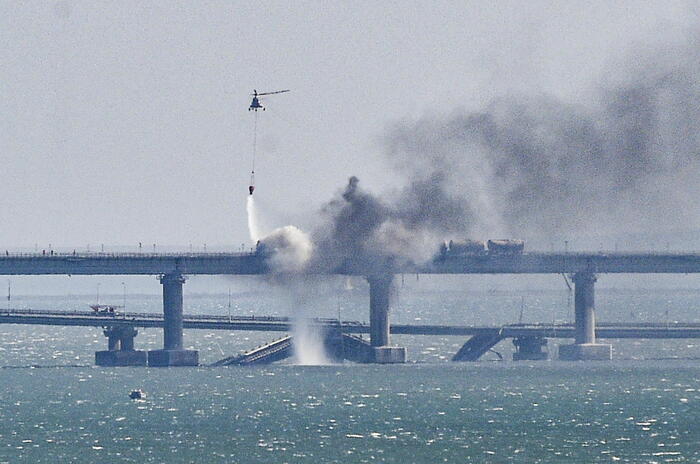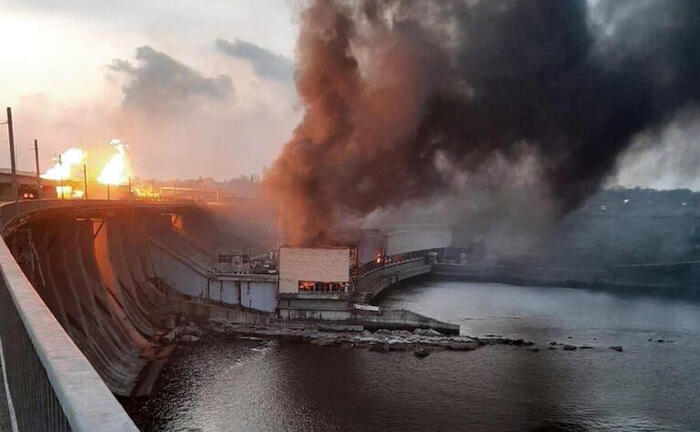The collapse of the dam of the Nova Kakhovka hydroelectric power plant particularly affects the inhabitants of the villages located on the banks of the Dnieper River on its way to the Black Sea, but also hinders the Ukrainian counteroffensive that began last Monday. The dam breach does not pose a threat to the country's power grid, according to the Ukrainian government, but it is a critical area for water supply to the Russian-occupied Crimean peninsula.
Accounts of what happened early Monday are contradictory. Ukraine accuses Russia of having destroyed the dam to stop the counteroffensive. Russian authorities said on Tuesday morning that it had collapsed from damage sustained during the fighting, but hours later, the Russian Foreign Ministry called the event a "premeditated and intentional terrorist attack" by the "Kiev regime." The use of this type of infrastructure as a weapon of war is a war crime, according to the Geneva Conventions. Satellite images and the first videos released Tuesday morning showed the dam collapsed and the water flow released. Other satellite images captured by Maxar on Monday, June 5, show the destruction of a segment of one of the roads next to the building that houses the turbines, indicating that the retaining wall had already been damaged.
Aerial video of the dam. Reuters
Satellite view of the dam, Tuesday. Planet Labs
The infrastructure, from the western part. Reuters
The dam, on June 5, already showed damage. Maxar
The affected population. The Dnieper riverbed is currently the border between the two contenders in the southeast of the country, since the withdrawal of Kremlin forces from the west bank last November. The Russians control the territory of the eastern bank of the river (the left if you go downstream). Nova Kakhovka, a municipality of 45,000 inhabitants (before the war), is located in this part of the river, under the control of the invading Russian troops. The water level had risen on Tuesday afternoon about 12 meters, according to Efe. About 900 people have been evacuated from the town, according to Russian emergency services.
Some of the localities evacuated due to flood risk
On this map, north is towards this direction
UKRAINE
Zone
Expanded
N
Dnieper River
Dnieper River
Hydroelectric power station and dam
Nova
Kakhovka
Kozatske
Burgunka
Mikolavka
Olhivka
Tiaguinka
Low area
Russian control
Poniativka
Mikilske
Sadove
Antonivka
Oleshki
Kherson
Komishani
Zimivnik
Priozene
Golo Pristan
10 km
Some of the localities
evacuees due to flood risk
On this map, north is towards this direction
UKRAINE
Zone
Expanded
N
Dnieper River
Dnieper River
Hydroelectric power station and dam
Low area
Ukrainian control
Kozatske
Nova Kakhovka
Burgunka
Mikolavka
Olhivka
Tiaguinka
Poniativka
Mikilske
Sadove
Low area
Russian control
Antonivka
Oleshki
Kherson
Komishani
Zimivnik
Priozene
Golo Pristan
10 km
Some localities evacuated due to flood risk
UKRAINE
Zone
Expanded
Low area
Ukrainian control
Dnieper River
Burgunka
Olhivka
Kozatske
Tiaguinka
Mikolavka
Poniativka
Mikilske
Nova Kajovka
Antonivka
Sadove
Priozene
Jersón
Zimivnik
Oleshki
Low area
Russian control
Komishani
10 km
Golo Pristan
Some localities evacuated due to flood risk
UKRAINE
Zone
Expanded
Low area
Ukrainian control
Dnieper River
Burgunka
Olhivka
Kozatske
Hydroelectric power station and dam
Tiaguinka
Mikolavka
Poniativka
Nova Kakhovka
Mikilske
Antonivka
Sadove
Priozene
Kherson
Zimivnik
Oleshki
Low area
Russian control
Komishani
10 km
Golo Pristan
The flooding of the banks of the Dnieper between the dam and the mouth has its counterpoint in the rapid drop in the water level that the inhabitants of Zaporizhia have witnessed, bathed by the waters of a reservoir that drains due to the leak, as shown by the images of its banks on Tuesday.
Flooding in Nova Kakhovka. EFE.
Lowering of the water level in Zaporizhia. Europa Press.
Ukraine's Prosecutor General's Office said about 40,000 citizens should be evacuated, about 17,000 in the Kiev-controlled part and about 25,000 in occupied areas. The authorities announced that buses had been sent to transport the population from the towns under Ukrainian control to other municipalities such as Mikolaiv, Khmelnitsky, Odessa, or the capital, Kiev. At noon on Tuesday, they reported that 24 towns on the west bank were flooded, and that about 1,000 people had already been evacuated from towns such as Kozatske, Burgunka, Tiaguinka or Sadove, including several districts of the city of Kherson, according to the Telegram channel of the Ministry of Internal Affairs of Ukraine. Authorities have also advised residents of several villages to move to squares or streets away from the river. The Secretary General of the United Nations, António Guterres, has described as "monumental human, economic and ecological catastrophe" the consequences in the affected localities on the banks of the Dnieper, which the Ukrainian Government estimates at 80.
On the western bank of the river, 60 kilometers downstream from the destroyed dam, is the city of Kherson, near the river mouth to the Black Sea and under Ukrainian control since it was recaptured by Kiev's forces last November. Estimates of the affected population are complicated, considering that less than half of the nearly 300,000 inhabitants who lived in Kherson before the start of the conflict remain in the city.
Geostrategic importance. The dam maintains the water level in the Kakhovka reservoir, which is 230 kilometers long and reaches the city of Zaporizhia. From the sheet comes the water used for cooling the six nuclear reactors of the largest nuclear power plant in Europe, the town of Energodar, 140 kilometers from the dam upstream. Both the International Atomic Energy Agency (IAEA) and the Russian government, which controls the plant, have assured, however, that the nuclear facility is not threatened.
The destruction of the dam has, on the contrary, a direct impact on the Nova Kakhovka power plant, in the vicinity of the overflowing wall, but does not pose a direct threat to the country's electricity supply, according to Ukrainian Energy Minister German Galushchenko.
From the same area of the Dnieper starts the canal that supplies almost all the water used in the Crimean peninsula, illegally annexed by Russia in 2014. Hence, the Ukrainian side aspired for months to take control of the city of Nova Kakhovka, as the special envoy of EL PAÍS Cristian Segura related: Kiev's intention was to take over the ability to close the tap of the main canal that irrigates Crimea. With the disappearance of the dam, which acted as a bridge, the Ukrainian movement became complicated.
Follow all the international information on Facebook and Twitter, or in our weekly newsletter.
Subscribe to continue reading
Read without limits
Read more
I'm already a subscriber


/cloudfront-eu-central-1.images.arcpublishing.com/prisa/VBWGZ7VKWBCWFGCTCLPFTUNWTU.jpg)











